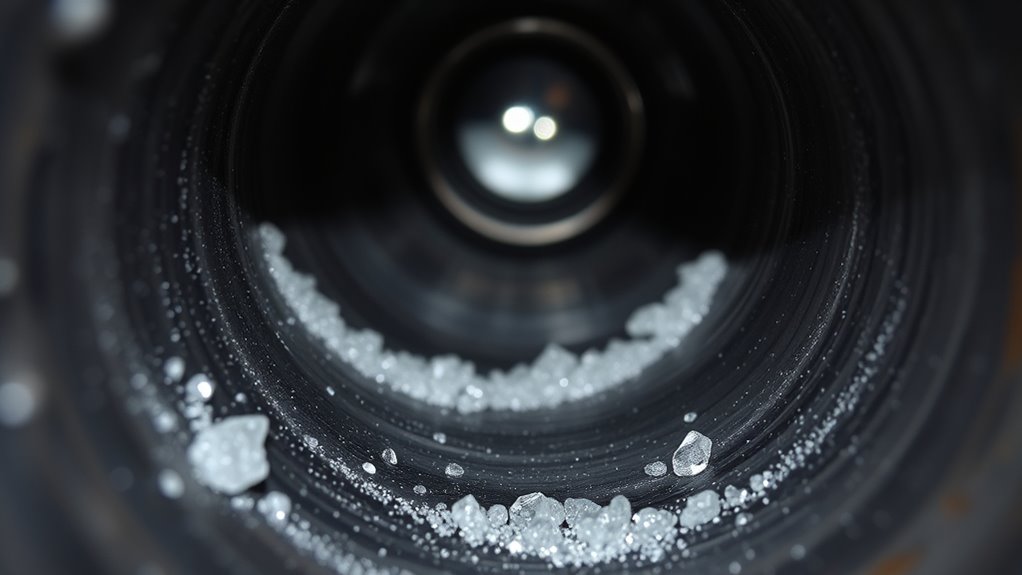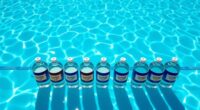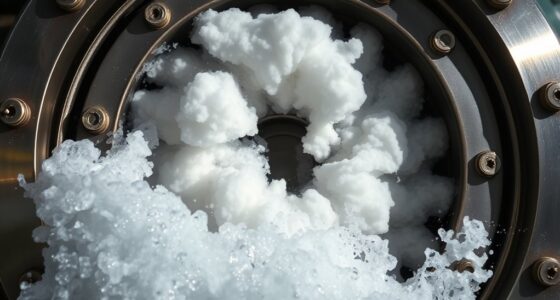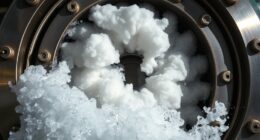To prevent scale buildup, focus on maintaining ideal LSI targets—usually between 0 and +0.5—by adjusting your water chemistry with acids, bases, or chelants. Implement fill-water hacks like softening, filtration, and calcium removal before system fill-ups, and monitor key parameters like pH, TDS, and hardness regularly. Consistently controlling these factors helps reduce mineral deposits. Continue exploring effective strategies to master scale prevention and extend your equipment’s lifespan.
Key Takeaways
- Maintain LSI targets between 0 and +0.5 by adjusting pH, alkalinity, and calcium levels using chemical treatments.
- Regularly test water parameters like TDS, calcium, and pH to ensure optimal LSI and prevent scale buildup.
- Use water softening methods such as ion exchange or reverse osmosis before filling systems to reduce mineral content.
- Incorporate descaling agents proactively based on water test results to inhibit mineral deposits.
- Implement automatic level controls and routine system maintenance to stabilize water chemistry and prevent scaling issues.
Understanding the Role of LSI in Scale Formation
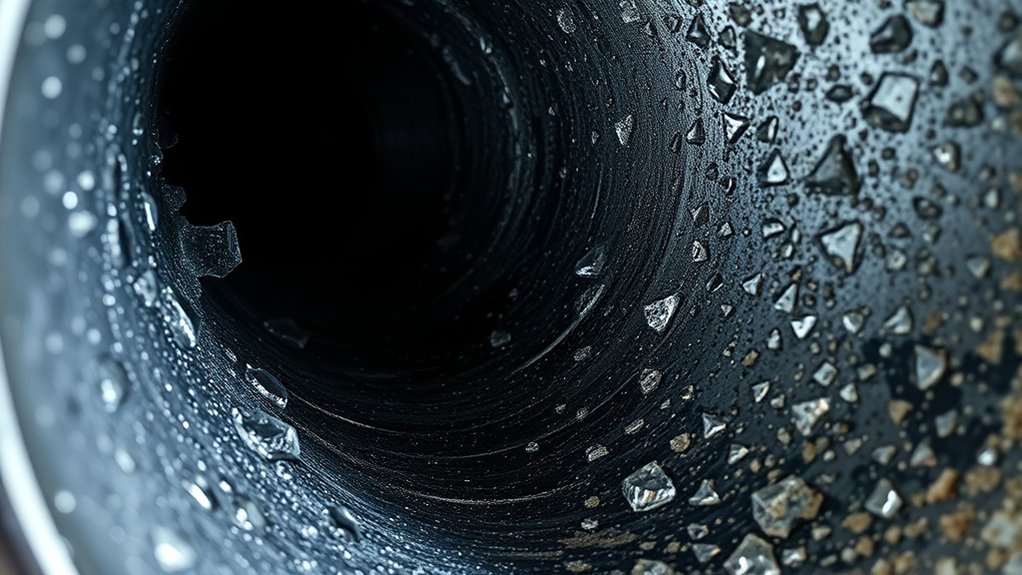
Understanding the role of LSI (Langelier Saturation Index) in scale formation is essential for predicting when minerals like calcium carbonate will precipitate out of your water. LSI measures how saturated your water is with respect to calcium carbonate. When the LSI is above zero, your water is supersaturated, meaning scale formation is likely. If it’s below zero, your water is undersaturated, reducing the risk of scale but possibly causing corrosion. By monitoring LSI, you can determine the likelihood of scale buildup and take proactive steps to prevent it. Knowing this helps you manage water chemistry more effectively, avoiding costly equipment damage and maintaining system efficiency. Mastering the LSI concept empowers you to keep your water balanced and scale-free. Additionally, understanding how water saturation levels influence mineral deposition can help you make more informed decisions about water treatment and maintenance.
How to Calculate and Set Optimal LSI Targets
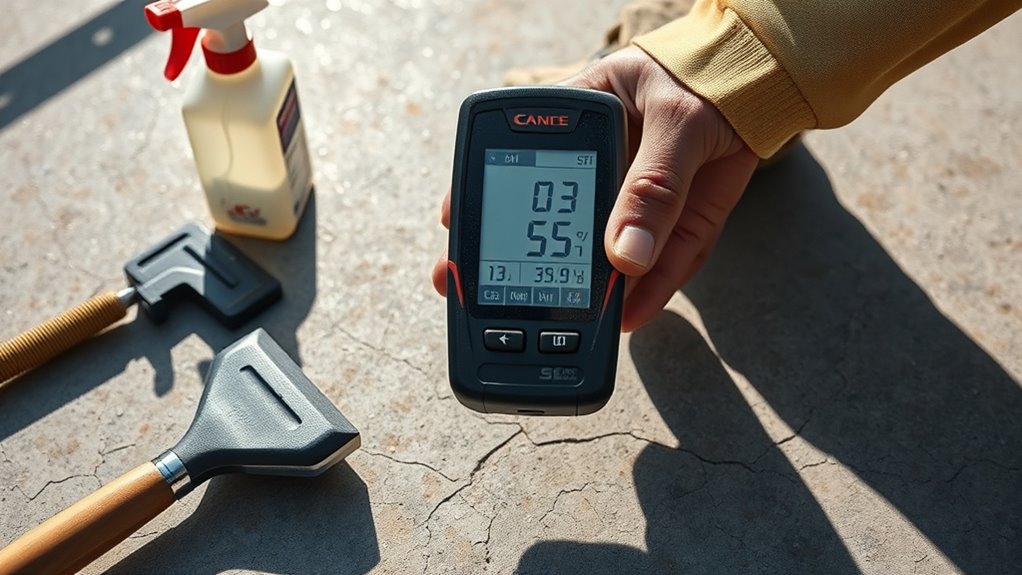
To effectively prevent scale buildup, you need to know how to calculate and set your ideal LSI targets. First, determine your water’s current pH, calcium, alkalinity, and temperature. Use an LSI calculator or chart to input these values and find the current LSI. Then, decide whether you want to slightly increase or decrease the LSI based on your equipment and water chemistry. Adjusting your water treatment methods—such as adding acids, bases, or chelants—can help you reach your target LSI. It’s also important to understand the HEPA filtration capabilities of your water treatment system to ensure optimal removal of contaminants. Here are three key steps:
- Measure and record water chemistry parameters accurately.
- Use a reliable LSI calculator to find your current LSI.
- Set a target LSI, typically between 0 and +0.5, to prevent scale formation effectively.
Practical Tips for Adjusting Water Chemistry to Control LSI

Adjusting your water chemistry to control LSI involves making precise modifications based on your measurements. First, monitor your pH, temperature, alkalinity, calcium, and sulfate levels regularly. If your LSI is too high, indicating potential scaling, reduce alkalinity or calcium by diluting with softer water or adding chemical inhibitors. Increasing pH slightly can also help prevent scale formation. Conversely, if LSI is too low, risking corrosion, you might need to add buffering agents or adjust pH upward. Always make incremental adjustments, then re-test to see their effects. Keep detailed records of changes to understand how each factor influences LSI. Remember, small, controlled modifications are more effective than drastic shifts, helping you maintain balanced water chemistry and minimize scale buildup. Monitoring these factors regularly is essential for effective scale prevention.
Fill-Water Management Strategies for Scale Prevention
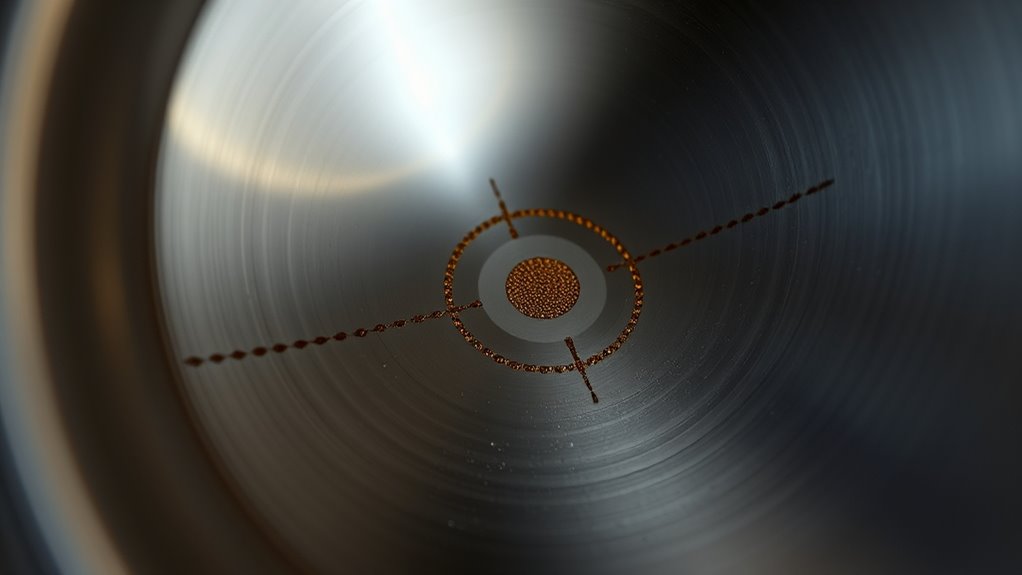
Maintaining essential water levels is vital for preventing scale buildup, so you should regularly monitor and adjust fill-water to stay within recommended ranges. Chemical treatment approaches can also help control mineral concentrations and inhibit scale formation. By combining proper level control with targeted treatments, you can effectively minimize scale risks in your system. Additionally, implementing filter maintenance routines ensures the removal of mineral deposits that could contribute to scaling.
Optimal Water Level Control
Have you ever wondered how controlling water levels can prevent scale buildup in industrial systems? Maintaining ideal water levels is key to avoiding conditions that promote scale formation. When water is too high, it can lead to excessive carryover of minerals; too low, and evaporation increases, raising mineral concentrations. To manage this effectively, consider these strategies:
- Use automatic level control systems to maintain steady water levels.
- Regularly calibrate sensors to ensure accurate readings.
- Implement feedback loops that adjust inflow and outflow based on real-time data.
- Monitoring mineral concentration is essential to prevent scale buildup.
Chemical Treatment Approaches
Chemical treatment approaches play a crucial role in fill-water management strategies aimed at preventing scale formation. You can add chemicals like scale inhibitors or dispersants to control the precipitation of minerals such as calcium carbonate or calcium sulfate. These chemicals work by either interfering with crystal growth or keeping minerals in suspension, reducing the likelihood of scale deposits. You’ll need to monitor water chemistry regularly to determine appropriate dosages and avoid over-treatment, which can cause other issues. Using corrosion inhibitors alongside scale preventers can also protect your equipment. Remember, chemical treatments should be part of a thorough water management plan that includes proper water analysis, controlled pH levels, and consistent monitoring. Incorporating filtration technology can further enhance water quality by removing impurities that contribute to scale formation. This combined approach maximizes scale prevention and maintains your system’s efficiency.
Implementing Effective Filtration and Softening Techniques
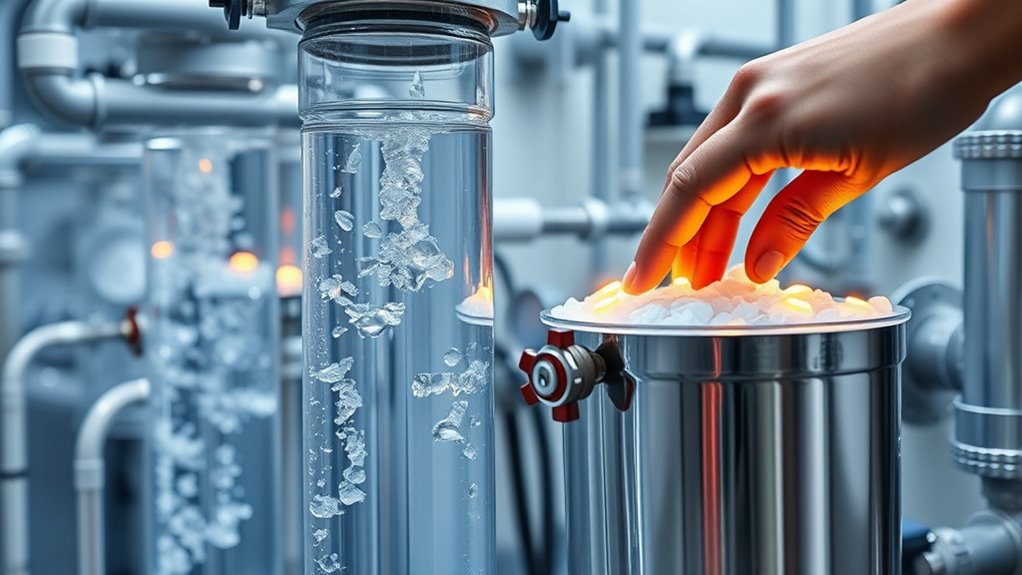
To prevent scale buildup, you need to choose the right filtration systems that suit your water quality. Optimizing your water softening methods guarantees minerals are effectively removed before they cause issues. By carefully selecting and tuning these techniques, you can keep your systems running smoothly and extend their lifespan.
Selecting Appropriate Filtration Systems
Choosing the right filtration system is crucial for effectively preventing scale buildup in your water system. Your choice depends on your water quality and system needs. First, consider a sediment filter to remove particles like dirt and rust, which can clog equipment. Second, a carbon filter helps eliminate chlorine and organic compounds that can contribute to scaling and taste issues. Third, if your water has high mineral content, a reverse osmosis system can greatly reduce calcium and magnesium levels, preventing scale formation. Ensure the system matches your water analysis results for maximum performance. Additionally, integrating AI-powered monitoring can optimize filter maintenance schedules and detect early signs of system inefficiency. Properly selecting and maintaining these filters will protect your equipment and extend its lifespan, saving you money and hassle in the long run.
Optimizing Water Softening Methods
Are you making the most of your water softening methods to prevent scale buildup? To maximize, focus on selecting the right techniques for your system. Proper regeneration cycles, salt levels, and flow rates ensure effective softening. Consider combining ion exchange with physical filtration for better results. Regular maintenance prevents salt bridging and resin fouling. Adjusting your softener settings based on water hardness tests ensures peak performance.
| Softening Technique | Best Practice |
|---|---|
| Ion Exchange | Regenerate regularly; monitor salt levels |
| Physical Filtration | Use pre-filters to remove debris |
| Reverse Osmosis | Supplement with softening methods |
| Chelating Agents | Treats existing scale buildup |
| Water Testing | Conduct tests monthly to adjust settings |
Monitoring and Maintaining Water Quality Over Time
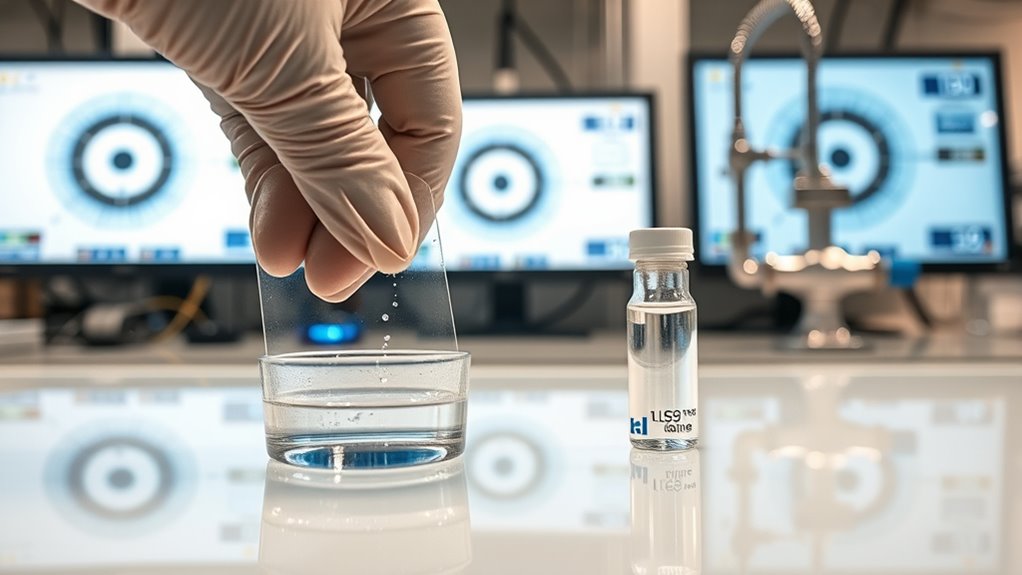
Regularly monitoring water quality is essential for preventing scale buildup and ensuring system efficiency. You need to keep a close eye on key parameters to catch issues early. Here’s what to focus on:
- Total Dissolved Solids (TDS): Measure TDS levels to identify changes that could lead to scaling problems.
- pH Levels: Maintain a stable pH to prevent corrosion and minimize scale formation.
- Water Hardness: Regularly test for calcium and magnesium concentrations, adjusting treatments as needed.
- Dreams and subconscious signals: Recognizing patterns in water quality fluctuations can sometimes reflect underlying stress or issues that may be influenced by the psychological significance of dreams and emotional well-being.
Troubleshooting Common Scale-Related Issues
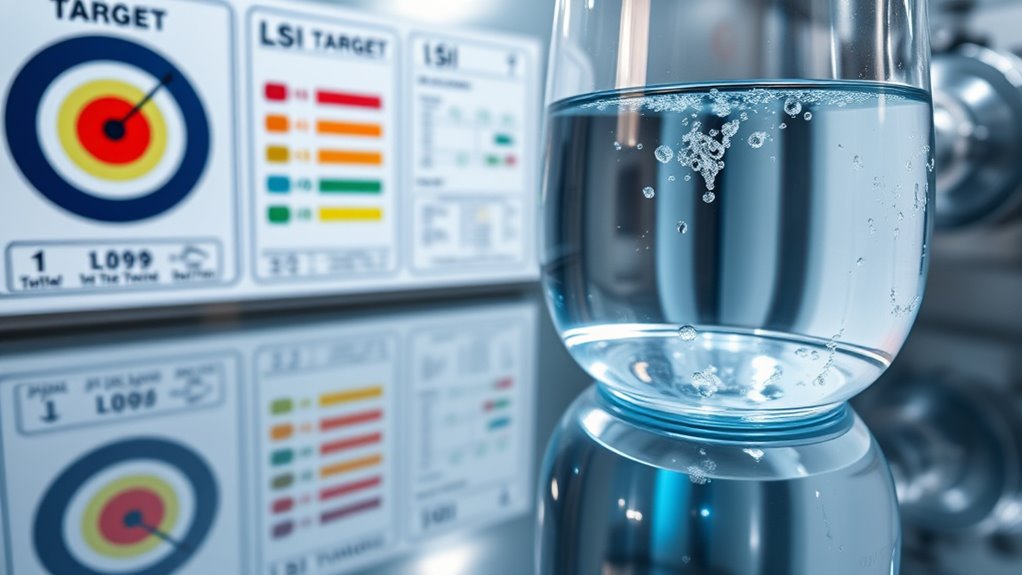
When water quality parameters like TDS, pH, and hardness indicate potential problems, troubleshooting scale-related issues becomes necessary. You should analyze these readings to identify the root cause. For example, high hardness suggests increased calcium or magnesium, leading to scale buildup. Adjustments may include water softening or chemical treatment. To better understand the situation, review the following:
| Issue | Cause | Solution |
|---|---|---|
| Excessive scaling | High mineral content | Install softeners or filters |
| pH imbalance | Acidic or alkaline water | Adjust pH with appropriate chemicals |
| Sudden scale formation | Water temperature fluctuation | Stabilize temperature, check equipment |
| Clogged pipes | Mineral deposits buildup | Flush system, use descaling agents |
| Equipment failure | Improper maintenance | Regular inspection and cleaning |
Additionally, implementing preventive maintenance strategies can reduce the likelihood of scale formation and extend equipment lifespan.
Frequently Asked Questions
How Do Seasonal Changes Affect LSI Targets and Scale Prevention?
Seasonal changes impact your LSI targets and scale prevention efforts because temperature fluctuations influence water chemistry. In colder months, water tends to be denser, raising LSI and increasing scale risk. Conversely, warmer seasons lower LSI, reducing scale formation. You need to adjust your chemical dosing and monitoring accordingly, ensuring ideal LSI levels year-round. Staying proactive helps prevent scale buildup, saving you maintenance time and costs during seasonal shifts.
What Are the Environmental Impacts of Using Fill-Water Hacks?
Using fill-water hacks can impact the environment by increasing water consumption, which strains local water resources and affects ecosystems. It may lead to higher energy use for water treatment and transportation, contributing to greenhouse gas emissions. Additionally, introducing untreated or poorly managed fill water could cause contamination or disrupt natural water balances. You should consider sustainable practices to minimize these environmental impacts while managing scale prevention effectively.
Can Scale Prevention Techniques Be Automated for Continuous Control?
Think of your system as a garden needing constant care. Yes, scale prevention techniques can be automated for continuous control. You set up sensors and control systems like a vigilant gardener who keeps pests at bay. These systems monitor water quality and adjust anti-scaling treatments proactively, ensuring smooth operation. Automation acts as your tireless gardener, preventing scale buildup before it becomes a problem, saving time and resources.
What Safety Precautions Are Necessary When Adjusting Water Chemistry?
When adjusting water chemistry, you should always wear appropriate personal protective equipment like gloves, goggles, and lab coats to prevent chemical exposure. Make certain proper ventilation in the area and follow manufacturer instructions carefully. Always add chemicals to water slowly to avoid splashing or dangerous reactions. Double-check chemical concentrations and document changes. Never mix chemicals unless you’re certain of the compatibility to prevent hazardous reactions. Safety always comes first.
How Do Different Industry Applications Influence Scale Prevention Strategies?
Different industry applications influence your scale prevention strategies because each environment has unique water chemistry, equipment, and operational demands. For example, power plants require aggressive scaling control due to high temperatures, while food processing needs strict purity standards. You must tailor your approach, adjusting chemical dosages, water treatment methods, and monitoring frequency accordingly. This guarantees ideal performance, minimizes downtime, and extends equipment lifespan across diverse industrial settings.
Conclusion
By understanding and managing LSI targets, you can keep scale at bay like a skilled captain steering clear of hidden rocks. Regularly adjusting your water chemistry and employing smart fill-water strategies act as your trusty compass, guiding you toward trouble-free operation. Stay vigilant with ongoing monitoring and maintenance, so your system runs smoothly. Think of it as tending a garden—consistent care keeps your water quality flourishing, preventing scale from taking root and causing chaos.
